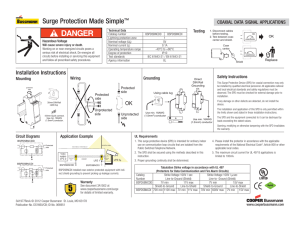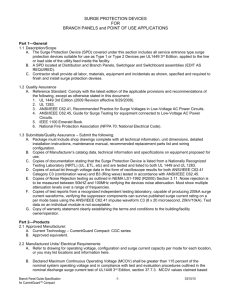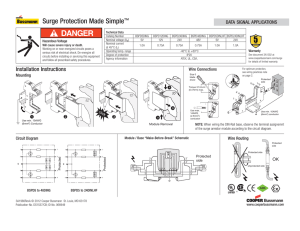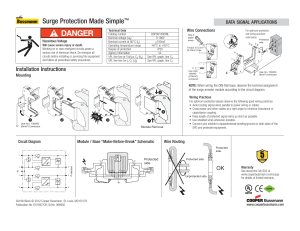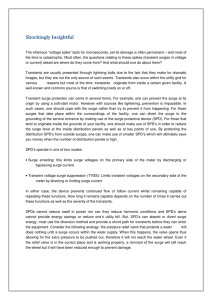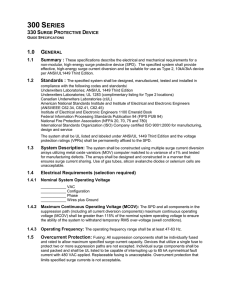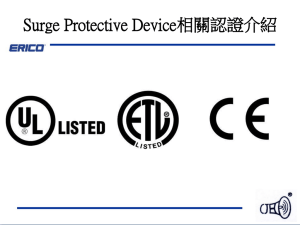Surge-Trap® SPD Application Information
advertisement
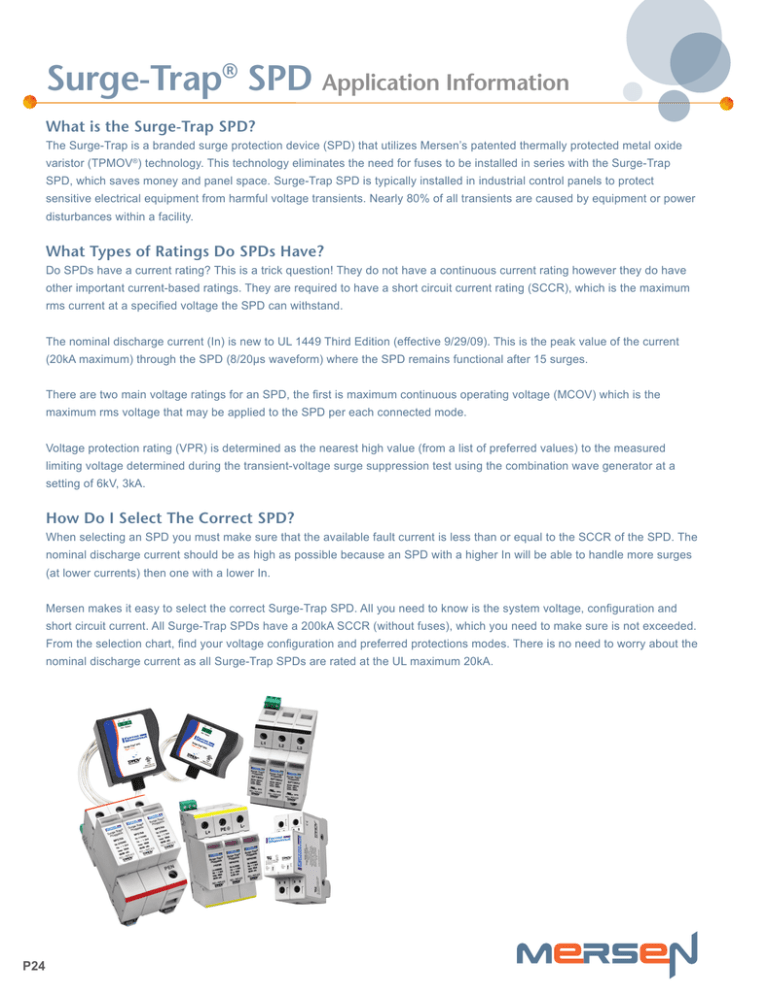
Surge-Trap® SPD Application Information What is the Surge-Trap SPD? The Surge-Trap is a branded surge protection device (SPD) that utilizes Mersen’s patented thermally protected metal oxide varistor (TPMOV®) technology. This technology eliminates the need for fuses to be installed in series with the Surge-Trap SPD, which saves money and panel space. Surge-Trap SPD is typically installed in industrial control panels to protect sensitive electrical equipment from harmful voltage transients. Nearly 80% of all transients are caused by equipment or power disturbances within a facility. What Types of Ratings Do SPDs Have? Do SPDs have a current rating? This is a trick question! They do not have a continuous current rating however they do have other important current-based ratings. They are required to have a short circuit current rating (SCCR), which is the maximum rms current at a specified voltage the SPD can withstand. The nominal discharge current (In) is new to UL 1449 Third Edition (effective 9/29/09). This is the peak value of the current (20kA maximum) through the SPD (8/20µs waveform) where the SPD remains functional after 15 surges. There are two main voltage ratings for an SPD, the first is maximum continuous operating voltage (MCOV) which is the maximum rms voltage that may be applied to the SPD per each connected mode. Voltage protection rating (VPR) is determined as the nearest high value (from a list of preferred values) to the measured limiting voltage determined during the transient-voltage surge suppression test using the combination wave generator at a setting of 6kV, 3kA. How Do I Select The Correct SPD? When selecting an SPD you must make sure that the available fault current is less than or equal to the SCCR of the SPD. The nominal discharge current should be as high as possible because an SPD with a higher In will be able to handle more surges (at lower currents) then one with a lower In. Mersen makes it easy to select the correct Surge-Trap SPD. All you need to know is the system voltage, configuration and short circuit current. All Surge-Trap SPDs have a 200kA SCCR (without fuses), which you need to make sure is not exceeded. From the selection chart, find your voltage configuration and preferred protections modes. There is no need to worry about the nominal discharge current as all Surge-Trap SPDs are rated at the UL maximum 20kA. P24 Surge-Trap® SPD Application Information How Is an SPD Installed and How Does It Work? A Surge-Trap SPD is always installed in parallel with the load. When the circuit has the normal operating voltage the SurgeTrap SPD will not be conducting current. Once the system experiences an overvoltage the Surge-Trap SPD will “turn on” and begin to conduct the extra voltage to ground, allowing the load to continue running at the correct voltage. This operation is similar to a pressure relief valve in a steam system. L+ L2 G L- G G/N G/N G G/N L1 L L1 N N G Single Phase 2 Wire + Ground L2 L3 G L2 G Split Phase 3 Wire + Ground 3 Phase Delta 3 Wire + Ground L1 L2 N L3 G 3 Phase Wye 4 Wire + Ground How Do I Retro Fit an Existing Panel? Providing there is adequate space, retro fitting an existing panel with a Surge-Trap SPD is easy. Typical industrial control panels will have a main disconnect that feeds a power distribution block (PDB) and then on to the individual loads. The SurgeTrap SPD mounts on standard 35mm DIN-rail typically found inside the panel. It should be installed as close as possible to the PDB and connected with #6-#14 AWG, the wire should not exceed 20” in length. It is important to make sure the wires are not P twisted together nor have any loops, as this will result in higher let-thru voltages. P25 Surge-Trap® SPD Application Information Q1: What is SPD? A: SPD is an abbreviation for “Surge Protective Device.” A SPD is a device that attenuates (reduces in magnitude) random, high energy, short duration electrical power anomalies caused by utilities, atmospheric phenomena, or inductive loads. Such anomalies occur in the form of voltage and current spikes with duration of less than half an AC cycle. These high-energy power spikes can damage sensitive electronic equipment, such as computers, instrumentation, and process controllers. Q2: How do surge suppressors work? A: Surge Suppressors are designed to divert high-energy power away from a load by providing a lower impedance path to common point earth ground. Surge suppressors used most often for panel board protection have metal oxide varistors (MOVs) connected in parallel. Q3: What types of components make up a surge suppressor? A: The device most commonly used in an AC surge suppressor is an MOV comprised of solid-state zinc oxide with multiple junctions. MOVs provide low impedance when conducting, and are packaged for specific voltages and current handling capacities. Other devices (more typically found in DC applications) include single junction diodes and gas tubes that ionize at preset voltages. Q4: Where are surge suppressors installed? A: AC surge suppressors are typically installed in these three areas: • At a utility service entrance for protection of an entire facility. • In distribution panel boards and switchboards for protection of sensitive downstream loads; • Connected to a wall outlet for individual protection of a specific piece of equipment, such as a computer or solid-state controller. Q5: What is surge current capacity? A: Surge current capacity, as defined by NEMA standards, is the maximum level of current a surge suppressor can withstand for a single transient event. This level is used to indicate the protection capacity of a surge suppressor. Q6: What is clamping voltage? A: Clamping voltage, also known as suppressed voltage rating (SVR), is the voltage a surge suppressor permits to pass to the attached load during a transient event. Clamping voltage is a performance measurement of a surge suppressor’s ability to attenuate a transient. This performance value is confirmed by Underwriters Laboratories (UL) during tests conducted while evaluating a surge suppressor for listing. Q7: What features should be considered when selecting a surge suppressor? A: Two important areas to consider during the selection of a surge suppressor are performance and safety, and include the following criteria: Performance: 1) surge current capacity; and 2) Short circuit rating. Make sure your surge device is not fuse limited. Many manufactures need fusing in front of the device to pass UL testing conditions. P26 Surge-Trap® SPD Application Information Q8: What is important when specifying a SPD? A: When specifying SPD, submit a clear, concise specification detailing the required performance and design features. A minimum specification should include: • UL surge rating • Suppression rating • Short circuit rating • Peak surge current per mode (L-N, L-G, and N-G) • Voltage and configuration of electrical service Q9: What is the difference between UL 1449 Listed and UL 1449 Component Recognized? A: UL 1449 Component Recognized products are required to pass the same performance tests as UL 1449 Listed products. The main difference is the listed devices are packaged differently, meaning they are tested and listed in stand-alone enclosures. Q: What key changes were made in the UL 1449 3rd Edition? A: The UL 1449 3rd Edition includes all of the 2nd Edition changes plus the addition of more rigorous safety testing requirements. The major differences include (1) change in terminology from Transient Voltage Surge Suppressors to Surge Protective Devices, (2) the UL 3rd Edition is now an American National Standard (ANSI), (3) addition of nominal discharge current ratings and markings (4) duty cycle test at nominal discharge current, and (5) measured limiting voltage now performed at 6kV / 3kA. Q10: What are C62.41 and C62.45? A: C62.41 and C62.45 are IEEE standards used to describe the characteristics of a transient and how a surge suppressor is tested to evaluate performance. C62.41 defines a transient and describes the transient environment at three separate facility locations. These locations are a service entrance (Category C-the most severe), a distribution panel board or switchboard (Category B), and a wall outlet (Category A). C62.41 is also a reference document that specifying engineers refer to for application information for defining a transient environment in a particular facility location. C62.45 describes in detail how a surge suppressor performance test is to be conducted. Q11. How is the Surge-Trap SPD more cost efficient than other SPD options? A: The Surge-Trap SPD is a no-fuse surge suppressor. 1. It does not need coordinated fusing or have the expense of the fuses, fuse holder, additional wiring and in meeting the UL or IEC requirements/standards. 2. Surge-Trap’s compact design helps save valuable space in the cabinet. 3. Offers modular and pluggable din-rail style with IP20 grade finger-safe protection. P 4. Complies with latest UL 1449 Third Edition and IEC 61643-1 Standards. P27 Surge-Trap® SPD Glossary & Definitions The following definitions apply specifically to surge protective devices (SPD). They are provided for further clarification of the performance specifications in the data sheets. Crest Value (peak): The maximum value that a wave, surge, or impulse attains. It is generally associated with the front of a wave. Clamping Voltage: The peak voltage across the surge protective device (SPD) measured under the conditions of a specified surge current and waveform. Peak voltage and peak current are not necessarily coincident in time. Impulse: A wave (surge) of unidirectional polarity. In testing, the rise time and duration of the impulse are specified, e.g., an 8/20µs impulse, a 10/350µs impulse. Maximum Continuous Operating Voltage (MCOV): The maximum rms value of the power frequency voltage that may be applied continuously between the terminals of the surge protective device. Nominal System Voltage: A nominal value assigned to designate a system of a given voltage class, e.g., 120/240 Volt single phase. Note: see ANSI C84.1-1989 Operating Duty Cycle: One or more operations per unit of time as specified. Pulse Life: The number of surges of a specified voltage and current amplitude and waveform that may be applied to a SPD without causing a change of more than 10 percent in the clamping voltage. The time interval between surges must be specified. Maximum Single Impulse Current: The maximum amplitude of current which may be applied for a single 8/20µs impulse without causing device failure. Power Dissipation: The power dissipated by a protective device while connected to an AC line of the rated voltage and frequency while no over voltage condition or surge exists. Steady state power dissipation. Response Time: The time domain response of a surge protective device to the front of a voltage waveform depends on the rate-of-rise of the incident wave, the impedance of the surge source and connecting wiring, the effects of protective device reactance, and the response behavior of conducting mechanisms within active suppression elements. In other words, response to the front of a wave can be affected more by the test circuit conditions, including lead inductance, than by the response time of the active suppression element. Surge: A transient wave of current, potential, or power in an electric circuit. Surge Let-Through: The voltage seen by the protected load, includes the SPD clamp voltage plus the voltage drop in the connecting wires. The part of the surge impulse that passes through the protective device. Surge Protective Device (SPD): A device for limiting the surge voltage on equipment by discharging or diverting surge current. A SPD should be able to repeatedly perform these functions as specified. Turn-On Time: The time required for a device to make the transition from an “OFF” state to an “ON” state. Turn-Off Time: The time required for a device to make the transition from an “ON” state to an “OFF” state. Voltage-Current (V-I) Characteristics: The relationship between the suppressed voltage and the magnitude of the surge current which induces this voltage. P28

